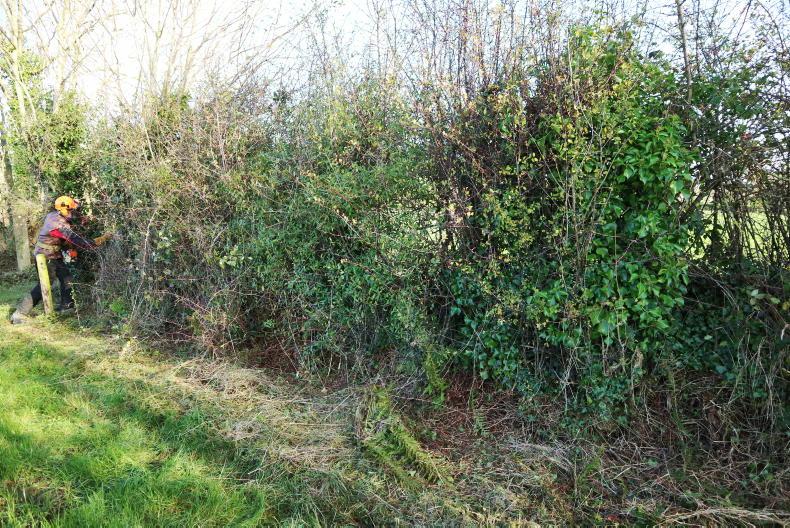A farmer has planted a hedgerow at our boundary fence. It is not a single hedge but three rows.
He is claiming it is for wildlife. They initially agreed to maintain it by verbal agreement.
Despite asking and texting he is ignoring our requests and now the hedgerow has grown in excess of two metres and it’s growing wild and darkening the views we experienced for the past nearly 20 years.
As a house owner, have we any say?
Trees/hedgerows along a neighbouring farmers property
Most agricultural boundaries are marked by hedgerows.
In practice, the boundary will be found in the middle of the hedgerow because the practice of the ordnance survey is to place the boundary in the middle of the hedge and ordnance survey maps were adopted when the folio plans were created by the Land Registry.
Mechanism to resolve disputes
In the event of a dispute in relation to the right to cut or maintain hedges or trees lying on a boundary between two adjoining landowners, the Land and Conveyancing Law Reform Act 2009 provides landowners with a mechanism to carry out the works.
In practical terms the person wishing to carry out the works should obtain the adjoining landowners consent in advance, setting out what work is to be done, when it is intended to do the work and why it needs to be done. However in the event of a dispute in exercising those rights, the person wishing to carry out the works can apply to Court for an order authorising the carrying out of those works. The Act provides that a person who wishes to carry out works to a party structure may do so for the purpose of:
Complying with statutory or planning requirements.For the preservation of his property.Any other works which will not cause either substantial damage or inconvenience for the adjoining owner.If they will cause such damage or convenience, it is nevertheless reasonable to carry them out.The legislation provides that the person carrying out the works shall pay the adjoining owner the reasonable costs of obtaining professional advice about the likely consequences of the works (such as engineers fees, legal advice etc) as well as reasonable compensation for inconvenience (such as where the works will interfere with the adjoining owners business). However the person who carries out the works can claim a reimbursement from the adjoining owner of such sum as will take into account the proportionate use or enjoyment which the adjoining owner will get from the works. If the adjoining owner fails, within a reasonable time, to meet a claim to a contribution, the person carrying out the works can recover the contribution as a simple contract debt in court. It is always in the best interests of all parties to achieve agreement where works are intended to be carried out to a party structure or boundary. However, where agreement cannot be reached, the Act provides a welcome mechanism to resolve the matter based on defined legislative rules.
Right to light
The owner of a house has no right to the supply of lateral light to a particular window unless there is an acquired easement of light to this window appurtenant to his house. What the easement provides is freedom from nuisance with that natural light. The easement of light is most commonly established by prescription, the same way as rights of way generally arise. The easement of light cannot be claimed in respect of open ground, so there will be no right attached to a garden. The Prescription Act 1832 only protected light for a ‘dwelling house, workshop or other building’. To bring an action, the claimant must prove that the obstruction has diminished the light. In considering whether the deprivation of light constitutes a nuisance, several factors are taken into account. For example the courts have held that a substantial diminution (decrease) in the amount of light will not constitute an actionable nuisance if the evidence is that sufficient amount of light remains. However where the premises are so badly lit that the slightest deprivation (lack) of light would substantially inconvenience the occupier in his business, he is entitled to relief on such deprivation.
If a claimant to a right of light is successful in his/her action the courts would normally either grant an injunction to stop interference with the right to light being complained of or alternatively an award of damages as a form of compensation.
Disclaimer: The information in this article is intended as a general guide only. While every care is taken to ensure accuracy of information contained in this article, Aisling Meehan, Agricultural Solicitors does not accept responsibility for errors or omissions howsoever arising. Email aisling@agrisolicitors.ie
A farmer has planted a hedgerow at our boundary fence. It is not a single hedge but three rows.
He is claiming it is for wildlife. They initially agreed to maintain it by verbal agreement.
Despite asking and texting he is ignoring our requests and now the hedgerow has grown in excess of two metres and it’s growing wild and darkening the views we experienced for the past nearly 20 years.
As a house owner, have we any say?
Trees/hedgerows along a neighbouring farmers property
Most agricultural boundaries are marked by hedgerows.
In practice, the boundary will be found in the middle of the hedgerow because the practice of the ordnance survey is to place the boundary in the middle of the hedge and ordnance survey maps were adopted when the folio plans were created by the Land Registry.
Mechanism to resolve disputes
In the event of a dispute in relation to the right to cut or maintain hedges or trees lying on a boundary between two adjoining landowners, the Land and Conveyancing Law Reform Act 2009 provides landowners with a mechanism to carry out the works.
In practical terms the person wishing to carry out the works should obtain the adjoining landowners consent in advance, setting out what work is to be done, when it is intended to do the work and why it needs to be done. However in the event of a dispute in exercising those rights, the person wishing to carry out the works can apply to Court for an order authorising the carrying out of those works. The Act provides that a person who wishes to carry out works to a party structure may do so for the purpose of:
Complying with statutory or planning requirements.For the preservation of his property.Any other works which will not cause either substantial damage or inconvenience for the adjoining owner.If they will cause such damage or convenience, it is nevertheless reasonable to carry them out.The legislation provides that the person carrying out the works shall pay the adjoining owner the reasonable costs of obtaining professional advice about the likely consequences of the works (such as engineers fees, legal advice etc) as well as reasonable compensation for inconvenience (such as where the works will interfere with the adjoining owners business). However the person who carries out the works can claim a reimbursement from the adjoining owner of such sum as will take into account the proportionate use or enjoyment which the adjoining owner will get from the works. If the adjoining owner fails, within a reasonable time, to meet a claim to a contribution, the person carrying out the works can recover the contribution as a simple contract debt in court. It is always in the best interests of all parties to achieve agreement where works are intended to be carried out to a party structure or boundary. However, where agreement cannot be reached, the Act provides a welcome mechanism to resolve the matter based on defined legislative rules.
Right to light
The owner of a house has no right to the supply of lateral light to a particular window unless there is an acquired easement of light to this window appurtenant to his house. What the easement provides is freedom from nuisance with that natural light. The easement of light is most commonly established by prescription, the same way as rights of way generally arise. The easement of light cannot be claimed in respect of open ground, so there will be no right attached to a garden. The Prescription Act 1832 only protected light for a ‘dwelling house, workshop or other building’. To bring an action, the claimant must prove that the obstruction has diminished the light. In considering whether the deprivation of light constitutes a nuisance, several factors are taken into account. For example the courts have held that a substantial diminution (decrease) in the amount of light will not constitute an actionable nuisance if the evidence is that sufficient amount of light remains. However where the premises are so badly lit that the slightest deprivation (lack) of light would substantially inconvenience the occupier in his business, he is entitled to relief on such deprivation.
If a claimant to a right of light is successful in his/her action the courts would normally either grant an injunction to stop interference with the right to light being complained of or alternatively an award of damages as a form of compensation.
Disclaimer: The information in this article is intended as a general guide only. While every care is taken to ensure accuracy of information contained in this article, Aisling Meehan, Agricultural Solicitors does not accept responsibility for errors or omissions howsoever arising. Email aisling@agrisolicitors.ie









SHARING OPTIONS